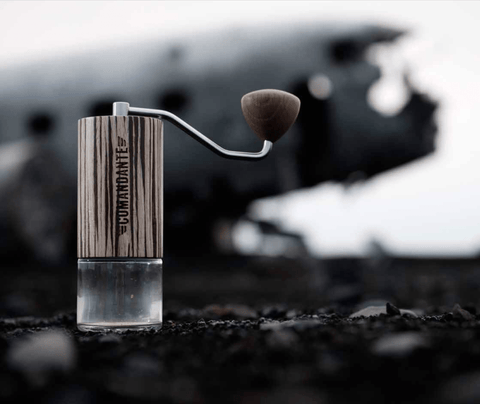The guys from hand-grinder company Comandante run us through the geeky stuff behind one of the most beautiful pieces of coffee equipment we’ve used.
The baseline for a good, clean cup is to buy freshly roasted beans and to grind them yourself right before brewing.
Regarding the grinder, don’t settle for one of those vintage electrical household blenders with rotating cutting blades. You will not get a homogeneous grind. The result will be a melange of particles and dust with no real target peak in your particle distribution.
I also avoid ceramic burr sets. Yes, they are dirt cheap and yes, they grind your coffee. But ceramic teeth are generally not very sharp and their edge holding capability is lousy. They produce too much dust and they give you a ‘fat’ normal distribution in particle size, resulting in a masked taste profile in your cup.
A solid cup always starts with a steel burr set. It really doesn’t matter much if it is a flat or conical burr set, though I prefer a well-made conical burr since I fancy slow brewing and dripping techniques.

When it comes to state-of-the-art conical burrs, three important factors come into play: burr geometry, material, and machining quality.
Most industrial steel burrs on the market were developed for espresso grinders. Needless to say, a hand grinder targeting the specialty coffee enthusiast requires different burr geometry and teeth design.
Finding the right steel for a conical burr is like choosing steel for making a knife. You have different options and some important physical elements to consider, depending what you expect from your knife and what you need it for. From a pure manufacturing standpoint, a steel that is easy to cut and shape is preferable. The user will have a different opinion about the ‘right’ steel. Making a good knife is not easy. Making a good conical burr is extremely difficult.
Normal steels are relatively easy to cut, but they will oxidise and rust. In order to make these burrs last and maintain sharp edges, they have to be hardened through heat treatment or coated with a thin layer of a hard substance.
If you’re only grinding dark roasted coffee, rust isn’t such a big issue. But if you’re a specialty coffee enthusiast, keep in mind that the best arabica beans are light roasted. They are harder and they have delicate acidic bio-chemical properties. Perfect grind and brewing technique should result into a sweet cup with a silky mouthfeel and a pleasant, lingering aftertaste. But arabica’s desirable chemical properties may react strongly when in contact with normal steel, and taste suffers. Delicate fruity oils and acids can be lost through oxidation.

It seems like the solution would be a stainless steel burr. In the kitchen, you’ll use a stainless steel knife to cut delicate foods because stainless steel’s high chromium content makes it more resistant to oxidation.
However, stainless steel is a pretty soft material with lousy edge-holding capabilities. With an abrasive bio-chemical substance like light roasted arabica, it dulls quickly. A dull burr is a disaster.
Many technologies exist to harden normal carbon steel, but it is difficult and costly to harden high chromium content stainless steel. The perfect burr material for specialty coffee is a stainless steel alloy which is hard and highly inert (electro-chemical neutral).
The Nitro Blade burr set is the ultimate performance choice. Both ring and core are made of a solid block of high-alloyed, high-nitrogen stainless steel. The Nitro Blade steel surface is inert, performing with absolute sensoric neutrality.
The key to Nitro Blades’ sharpness and edge-holding capability is a super fine Martensitic steel crystal matrix with a carbide micro structure. The results? Burr teeth and blades are tough and they’re wear-resistant with excellent edge retention.
This high-nitrogen steel is difficult to manufacture. Finishing the final burr surface is complex. But the results are awesome: grind tests with Nitro Blade show a narrow distribution around the target particle size and reduced dust occurrence.
Try Nitro Blade with a mountain arabica from Costa Rica, an Ethiopian heirloom or a precious Panama Geisha and you get a clean, sweet cup with a silky mouthfeel — exactly what I was looking for when I developed this burr set.



